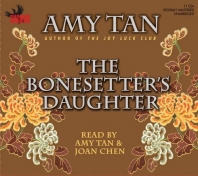BKMT READING GUIDES
The Bonesetter's Daughter
by Amy Tan
Published: 2006-01-01
Audio CD : 0 pages
Audio CD : 0 pages
14 members reading this now
29 clubs reading this now
17 members have read this book
29 clubs reading this now
17 members have read this book
No other editions available.
Jump to
Introduction
Tan's phenomenal #1 national bestseller is now available in trade paperback. "A compelling tale of family relationships; it layers and stirs themes of secrets, ambiguous meanings, cultural complexity, and self-identity; and it resonates with metaphor and symbol."--"The Denver Post."
Discussion Questions
Questions from Publisher's Reading Guide:1. Bones constitute an important motif in The Bonesetter's Daughter.
What is the significance of the book's title? How does breaking
a bone change Ruth's life and her relationship with her
mother? What importance do bones hold for LuLing and Precious
Auntie?
2. Each year, Ruth makes a conscious decision not to speak for one
week. Why does she elect to go silent? In which ways does this
self-imposed muteness mirror the challenges faced by both her
mother and by Precious Auntie? How does Ruth find her voice as
the novel goes on?
3. From childhood onward, Ruth is locked in a constant struggle
with her mother. In which ways does her behavior echo LuLing's
rebellion against her own mother? How do these conflicts have
violent consequences, both physical and emotional?
4. To frame the novel, Tan uses the device of a story within a story.
How is this effective in bringing past and present together?
5. How does LuLing come to life in her own words, and how is that
vantage point different from Ruth's point of view? How is the
LuLing that springs to life in her manuscript different from the
figure Ruth grapples with on a regular basis?
6. LuLing begins her story, "These are the things I must not forget."
Why is she so adamant about remembering--and honoring--
what has come before? In contrast, what is Precious Auntie's attitude
toward the past? In which ways does she recast prior events,
thus concealing the truth from LuLing? How does Ruth grapple
with what she uncovers about the history of her family, and what
it means for her future?
7. Ruth is shocked to learn that her aunt, GaoLing, is not her
mother's real sister. How does the relationship between the two
women defy the adage that blood is thicker than water?
8. How does the dynamic between LuLing and GaoLing evolve as
the book unfolds? What emotions does LuLing feel most strongly
toward GaoLing, and vice versa? Why?
9. Although GaoLing speaks English fluently, by contrast, LuLing
never learns to communicate effectively in the language, instead
relying on Ruth to be her mouthpiece. How is the spoken word
depicted in this novel? Is it more or less important than the written
word? How does LuLing communicate in other ways--for
example, artistically?
10. How does the concept of destiny shape the lives of both Precious
Auntie and LuLing? How does each woman fight against the
strictures of fate? In the modern world, does destiny hold as
much weight? Why or why not?
11. Both Precious Auntie and LuLing lose love in tragic ways. How is
romantic love depicted in The Bonesetter's Daughter? How does
Ruth's concept of love differ from that of her grandmother's and
mother's? Does LuLing's conception of love evolve over time?
12. LuLing is introduced to Western ideas and religion while living
and working in an American-run orphanage. How does she reconcile
these different ideologies with the beliefs she holds? Does
her belief in her family's curse fade or blossom within the confines
of a different societal framework?
13. How does LuLing forge a new life for herself in America? In
which ways does she remain constrained by the past, and in
which ways does she triumph over it?
14. Which of GaoLing's characteristics enable her to adjust to
America with more ease than her sister? Which make it more
difficult?
15. "Orchids look delicate but thrive on neglect." In which way does
this idle musing by Ruth apply to the other relationships in the
novel, including her own with Art and his children?
16. Ruth has lived with the specter of Precious Auntie her entire life.
How does her mother's obsession with Precious Auntie affect
Ruth? Do you view Precious Auntie's presence next to Ruth in
the last scene of the book as a figurative or a literal one? Why?
17. Based on her manuscript alone, the translator of LuLing's story
becomes fascinated with her. What about her story, in your opin-
ion, is so alluring and transcendent? How does her fading mind
open her to new experiences?
18. As LuLing loses her memory, how does her story become more
clear to Ruth? How does Tan explore the transience of memory
in The Bonesetter's Daughter?
19. Ruth works as a successful ghostwriter. How is this profession
significant, both literally and figuratively, in her communication
with her mother and with the world around her? How has her
professional life opened Ruth to the world around her, and how
has it shut her off?
20. What significance do names and their nuances have in The Bonesetter's
Daughter? Why is it so important that Ruth discover her
family's true name? When Ruth discovers what her own name
means, how does that realization change her relationship with
LuLing?
Book Club Recommendations
Recommended to book clubs by 6 of 7 members.
MEMBER LOGIN
BECOME A MEMBER it's free
Book Club HQ to over 88,000+ book clubs and ready to welcome yours.
SEARCH OUR READING GUIDES
Search
FEATURED EVENTS
PAST AUTHOR CHATS
JOIN OUR MAILING LIST
Get free weekly updates on top club picks, book giveaways, author events and more
Get free weekly updates on top club picks, book giveaways, author events and more
Please wait...








